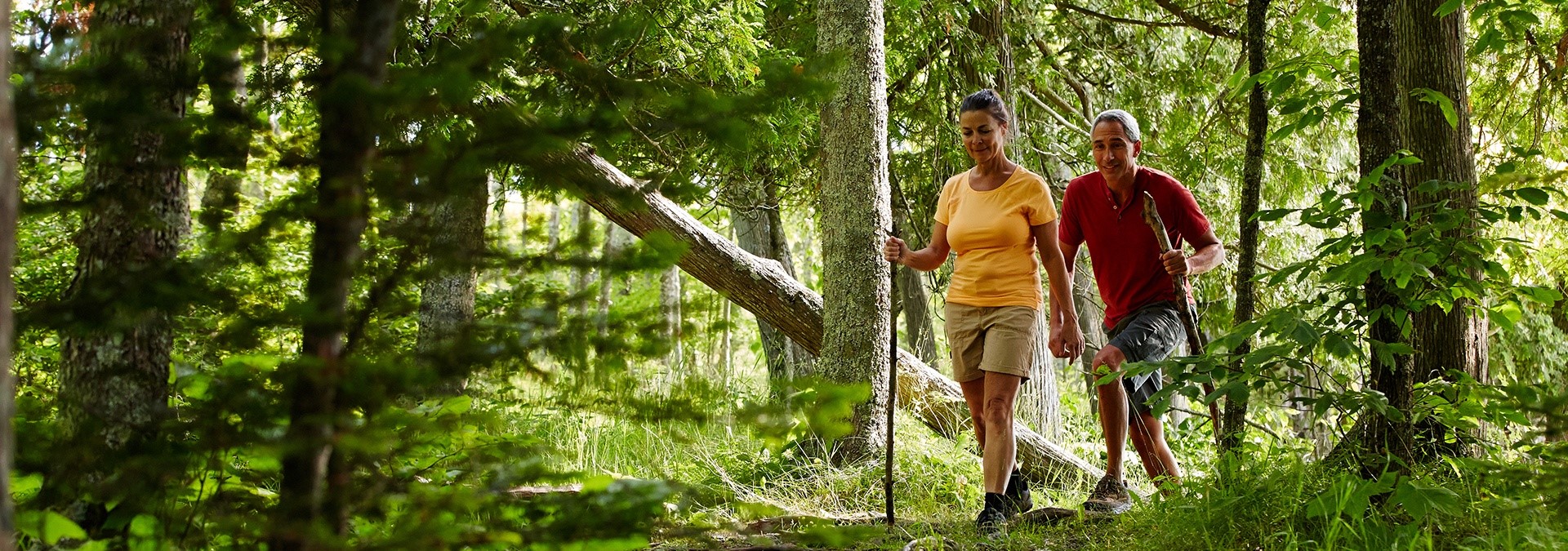
Geocaching: Naturalist Treasure Hunting
Published
Looking for a new and adventurous activity to keep you outdoors this summer? Give geocaching a try and go on an app-guided outdoor treasure hunt that can take you into the woods, along the beaches, and through the small towns of Door County. Only a smartphone or GPS and good walking shoes are needed.
What is Geocaching?
Billed as “the world’s largest treasure hunt,” geocaching got its start in 2000 when there was a breakthrough in consumer GPS technology that allowed everyday adventurers to carry clear, detailed, and accurate topographical maps in their pockets and backpacks.
Participants hide small, waterproof “caches”—such as plastic storage containers, repurposed food packaging, mason jars, film canisters, pencil boxes, and way more—with small trinkets, toys, tools, or items of interest for others to find. There’s also usually a logbook for geocachers to sign their names and leave their marks. The geocache’s coordinates get logged on the official smartphone app for others to discover and navigate to via the app’s GPS and map features.
Sometimes the caches are a little more complex and require solving a puzzle or involve multiple steps, but most are relatively easy to find with a little legwork and a curious spirit.
The person who finds the cache takes the item the previous person left and replaces it with their own item for the next person to find, creating an ongoing chain of people exploring new outdoor places, finding these mysterious geocaches, trading small items and tokens, connecting with nature and a community of like-minded travelers, and setting out to explore yet again.

Where to Find Geocaches in Door County
At time of writing, there are hundreds of unique individual geocaches just waiting to be uncovered all across Southern and Northern Door County as well as Washington Island, Rock Island, and Chambers Island.
Here are a few gems in the area, all of which will help you visit new places, see incredible views and landscapes, and flex your navigation skills:
- All 5 state parks—that’s Peninsula, Potawatomi, Whitefish Dunes, Newport, and Rock Island—have geocaches hidden among their hiking trails, beaches, and wooded areas. Make it a goal to visit one geocache in each park during your trip to get the full tour of our state parks.
Or, plan to visit one and follow the trail of geocaches across the park to get to know the landscape and scenery on a much deeper level. - Three nearby islands—Washington, Rock, and Chambers—each offer their own set of caches. They may require more time and effort to get to, but doing a weekend of island hopping will provide you with an entirely new and unique experience of Door County as well as plenty of caches to discover.
Spending the day on just one island searching for all its caches can also serve as an informal tour around a new place. - As a primarily outdoor activity, geocaching can yield discoveries in many of the places you’ll visit on an outdoor-centric trip. Even if you’re just launching your boat from a marina, hiking at a nature preserve, visiting a beach or lake, or camping for the weekend, it’s worth switching on the Geocaching app and checking for nearby treasures, wherever you are.
- Many of the area’s coolest attractions have a geocache nearby. When planning your trip and picking out stops, check the app for geocaches to make the visit a fuller experience.
Cana Island, Death’s Door, Cave Point, county parks, local sections of the Ice Age Trail, Door Bluff Headlands, and way more trails, outlooks/viewpoints, businesses, and nature spaces have caches hidden away nearby.

What to Bring Geocaching
- While a GPS device is useful for geocaching, a GPS-enabled smartphone with the official Geocaching app is your best bet.
- Sturdy shoes—this activity may have you hiking in the forest or traversing shoreline, so bring a trusted pair of hiking shoes with good traction.
- A pen for signing the logbooks and effectively saying: “I was here.”
- Water and sunscreen, especially if you’re going on a multi-geocache adventure and will be outdoors for a few hours.
- Your Leave No Trace knowledge. Geocaching does technically involve “leaving a trace,” but this is allowable when done in the spirit of the game and in a safe, eco-friendly way. Brush up on Leave No Trace principles as well as Geocaching rules and regulations, whether you’re searching for others’ caches or you’re planning to hide one yourself.
- Small items or objects of interest to leave behind in the cache for the next explorer. This can be just about anything small enough to fit inside a lidded container. Think coins, stones, keychains, pictures, trading cards, action figures or small toys/figurines, jewelry, and small but interesting objects of beauty. Avoid food, soaps/liquids, and other items that could be found by an animal or harm the ecosystem.
How to Get Started
Geocaching is a modern, digital, choose-your-own-adventure activity in its purest form. You’re given a map, a few hundred sets of coordinates, and the open road. Where you go, what you see, the kinds of environments you explore, the people you share it with, and the meaning and memories you take away from it are all yours to choose.
Here’s how to get started with this deeply rewarding activity:
- Download the app and set up a free account.
- Enter your location or your vacation destination and start browsing the hundreds of geocaches up here. Think about what kinds of scenery and landscapes you want to see—beaches, shorelines, marinas, islands, bluffs, forests, backroads, towns/villages, businesses, parks, etc.—and plan your cache stops around that.
- Plan out a route with one or more stops and make note what kind of environments you’ll be in. Dress accordingly!
- Put the coordinates of your first stop into a GPS and grab a friend or make a solo venture to the location. Expect to have to leave your car, hike at least a short distance, walk on varying terrain, and search/climb/squat/dig/reach/etc. until you find your reward. Not all geocaches are immediately visible, and for many, part of the fun is the hunt for the cache once you’ve reached the coordinates.
- Once you find your cache, pat yourself on the back for an adventure well done, uncover the object/s left behind for you to enjoy, leave a small object in place of the one you take, sign the logbook, and re-hide the cache.
- Take a deep breath and appreciate the beauty of the natural scenery around you.
- On to the next geocache!
If you’re new to geocaching, one great place to start is the Destination Door County visitor center in Sturgeon Bay.
We can’t say exactly where the cache is of course (there’s an app for that!), but if you find yourself passing through the area, stop by, check the map for nearby geocaches, and get a quick dose of excitement and adventure before heading out to explore the rest of our great outdoors.
Sign up today!
Visit Door County virtually with monthly newsletter updates. Each issue is jam-packed with vacation ideas, special offers, recipes, festivals, events, and more.
Subscribe to the Newsletter




